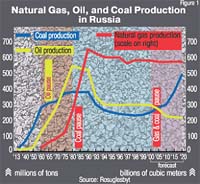 COMPANY
PROFILE COMPANY
PROFILE |
Mineral resources have always been the basis
for other industries, that's the reason why Primorskugol
has always attracted the businessmen and government's
attention.
It's considered that the mining industry of Primorye
plays the major role in the regional economy development.
In 2001, the Swiss Business Club has awarded
the company with the Gold Ingot international
award for long stable functioning.
The prestigious award has been presented to the
coal-extracting enterprise according to the results
of the analytical research held by the Technomic
Consultants S.A. The award was established by
INSAM, the Geneva Graduate Institute of Business
and Management to encourage the most stable enterprises
working in market economies.
The gold ingot with a mark of the Swiss State
Bank is the third prestigious award presented
to the company. Last year it was awarded with
the Gold Standard from the Russian Partnership
for Progress programme, and this year - with the
Russian National Olympus prize in the Fuel Complex
nomination.
 THE COAL
INDUSTRY THE COAL
INDUSTRY |
The geological reserves in Russia alone have
been estimated at three trillion tons. At the
current rate of production (265 million tons),
Russia would have enough coal for more than a
thousand years. In short, we will not be able
to avoid turning to coal as an energy source.
In 2001, 9.022 million tons of coals were extracted
in Primosky Krai with its calculated demand of
13.85 million tons. A series of separate basins
and deposits of brown and bituminous coals form
the resource. Primoryes's coals are utilized almost
exclusively as fuel for boiler and furnace units.
About 30% of all the coal Primorskugol JSC conducts
mining works.

|
The coal is of high
quality and can be strip-mined. A 1974 Soviet-Japanese
agreement gave rise to a mine capable of yielding
13 million tons/year, including 9 million tons/year
of coking coal destined for Japan, and a railway
line connecting the mine with the Trans-Siberian
Railway.
 THE FUTURE
OF COAL THE FUTURE
OF COAL |
At the current stage of coal sector restructuring,
the main focus is on two sets of objectives:
· to completely meet national coal demand
and to improve the efficiency of production so
that subsidies may be cut, eventually enabling
the coal sector to operate without any subsidies.
· to implement measures to improve the
efficiency of coal mine operation and to provide
timely social support for redundant personnel
to prevent the decline of their actual living
standards.

The economics of the coal sector are based on:
actual coal demand in regional markets and open
pricing, with due account for transportation costs;
a selective approach to subsidizing mines; a change
of the production structure and forms of ownership;
the development of free competition; and consolidation
of industrial and market structures.
In Eastern Siberia and the Far East, 90% of the
total coal output is provided by the most advanced
surface mining methods. The most profitable high-capacity
opencast mines have been constructed. Now these
enterprises are successfully operating. They are
equipped with high-performance domestic and foreign
mining and transport machinery. They use advanced
technologies, and depending on geological conditions
of coal deposits, production costs range from
RBL 35-100/t.
With the normal operation of the Russian economy,
such enterprises could work rather profitably
meeting demand for cheap fuel. These results provide
expectations that continued restructuring will
turn the coal industry into a profitable, reliably
operating sector, substantially improving the
country's energy security.
|

